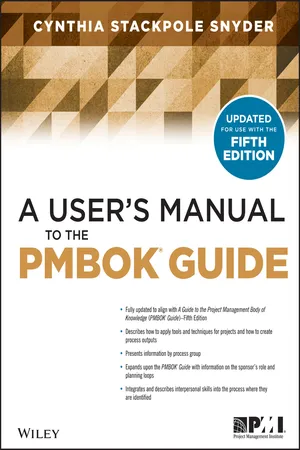
- English
- ePUB (mobile friendly)
- Available on iOS & Android
A User's Manual to the PMBOK Guide
About This Book
The must-have manual to understand and use the latest edition of the Fifth Edition
The professional standard in the field of project management, A Guide to the Project Management Body of Knowledge ( PMBOK® Guide— Fifth Edition) published by the Project Management Institute (PMI®) serves as the ultimate resource for professionals and as a valuable studying and training device for students taking the PMP ® Exam. A User's Manual to the PMBOK® Guide takes the next logical step to act as a true user's manual. With an accessible format and easy-to-understand language, it helps to not only distill essential information contained in the PMBOK® Guide— Fifth Edition, but also fills an educational gap by offering instruction on how to apply its various tools and techniques. This edition of the User's Manual:
- Defines each project management process in the PMBOK® Guide— Fifth Edition, describes the intent, and discusses the individual ITTOs (inputs, tools and techniques, and outputs)
- Features examples, handy tips, and sample forms to supplement learning
- Contains a data flow diagram of each process in the PMBOK® Guide— Fifth Edition to show how information is distributed
- Is updated to provide deeper coverage of stakeholder management and to include new processes for scope, schedule, cost, and stakeholder management
The User's Manual enables you to put the PMBOK Guide— Fifth Edition to work on your projects. It will help you implement the processes described in the PMBOK Guide— Fifth Edition and apply the tools and techniques to help make your projects successful. Thorough in coverage and rich in content, it is a worthy companion to augment the important strategies laid out in the PMBOK® Guide— Fifth Edition, and the one book that aspiring or professional project managers should never be without.
- Fully updated to align with A Guide to the Project Management Body of Knowledge ( PMBOK® Guide ) – Fifth Edition
- Describes how to apply tools and techniques for projects and how to create process outputs
- Presents information by process group
- Expands upon the PMBOK® Guide with information on the sponsor's role and planning loops
- Integrates and describes interpersonal skills into the process where they are identified
(PMBOK, PMI, PMP and Project Management Professional are registered marks of the Project Management Institute, Inc.)
Frequently asked questions
Information
Chapter 1
Introduction
- About This Book
- Project Management Process Groups
- Project Management Knowledge Areas
About This Book
Project Management Process Groups



Table of contents
- Cover
- Table of Contents
- Title
- Copyright
- Preface
- Acknowledgements
- Chapter 1: Introduction
- Chapter 2: Key Concepts
- Chapter 3: Initiating a Project
- Chapter 4: Planning Integration
- Chapter 5: Planning Scope
- Chapter 6: Planning the Schedule
- Chapter 7: Planning Cost
- Chapter 8: Planning Quality
- Chapter 9: Planning Human Resources
- Chapter 10: Planning Communications
- Chapter 11: Planning Risk
- Chapter 12: Planning Procurement
- Chapter 13: Planning Stakeholder Management
- Chapter 14: Executing the Project
- Chapter 15: Executing Quality Management
- Chapter 16: Executing Human Resource Management
- Chapter 17: Executing Communications Management
- Chapter 18: Executing Procurement Management
- Chapter 19: Executing Stakeholder Management
- Chapter 20: Monitoring and Controlling the Project
- Chapter 21: Monitoring and Controlling Scope
- Chapter 22: Monitoring and Controlling the Schedule
- Chapter 23: Monitoring and Controlling Cost
- Chapter 24: Monitoring and Controlling Quality
- Chapter 25: Monitoring and Controlling Communications
- Chapter 26: Monitoring and Controlling Risks
- Chapter 27: Monitoring and Controlling Procurements
- Chapter 28: Monitoring and Controlling Stakeholder Engagement
- Chapter 29: Closing the Project
- Appendix
- Index
- End User License Agreement